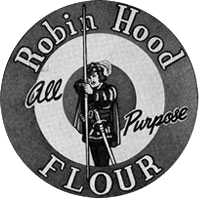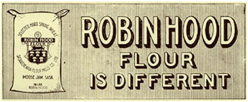Robin Hood –
The Wheat
and Chaff
From its modest beginnings in Moose Jaw in 1909, Robin Hood has established itself as a household name through hard work, foresight and innovation. Its green-and-red archer emblem has become a familiar and highly regarded symbol of quality and good value from coast to coast.

The
Edwardian Era
Men wore boater hats and spats, women wore floor-length dresses and crinolines. The first gene was discovered. A man reached the North Pole and another flew across the English Channel. 1909 was a year of industry and discovery, and Francis Atherton Bean, President of International Milling in Minneapolis, decided it was a fertile time to buy a mill in Moose Jaw, Canada.
The Birth of a Business
With a population of 7,000, Moose Jaw was Saskatchewan’s largest city. It was a rough frontier town established near a railroad. F.A. Bean’s mill opened to great excitement. It provided employment and encouraged outsiders to invest in the area. To honour his new staff of 50 workers and 12 field salesmen, Bean held a gala banquet and a “christening ceremony” where a barrel of wheat was turned out. In a short time, the mill had become a vital fixture in the local economy. Bean had it remodelled, and in less than two years it was producing over 1,600 barrels of flour a day.
The Roaring Twenties
People flocked to the new dance halls where flappers danced the Charleston, and Europe got a facelift from post-war treaties. Charles Ritz, the new president of Robin Hood, made the most of this sunny economic climate. As early as 1925, he made sure Robin Hood was a part of as many baking fairs and local exhibitions as possible. He also saw the importance of exporting flour and oats to struggling nations. And within the next ten years, millions of tonnes of Robin Hood products travelled from docks in Vancouver to shores all over the world.
The Thirties
Big Bands, Fred Astaire and Shirley Temple provided distractions from the economic slump. For Robin Hood, it was a decade of extraordinary growth. Its uniformly milled flour was now famous for its consistent quality, and it was in demand. Robin Hood products were travelling to far northern outposts, and some district managers even travelled by dog-sled to reach remote regions like Churchill and Frobisher Bay.

Robin Hood During Wartime
Munitions factories employed women and teenagers, and life staples, like flour, were in demand. Robin Hood responded by working at full tilt for the war effort. A new factory was built in Humberstone (present day Port Colborne), and business was booming. During the war years, Robin Hood became increasingly involved in the community. It produced the popular radio show, “On Parade.” Similar to “Name That Tune”, it offered prizes to winners and brought thousands of households some cheerful relief from wartime hardship.
A Helping Hand
Robin Hood milled “G.R. Flour”, and sent thousands of tonnes overseas as foreign aid. “G.R. Flour” was known by two names, “George Rex Flour”, after the English King, and “Government Reserve Flour” because it fed thousands of needy Europeans. Robin Hood also responded to a crisis at home. In the summer of 1950, Winnipeg had the worst flood in the history of North America. Robin Hood donated clothes, supplies, and a $10,000 cheque for the flood relief fund.
Times are a Changin’
“Flower Power” and a man on the moon-the Sixties were a decade of change. For Robin Hood it was a time of growth and expansion. By the end of the decade Robin Hood was producing hundreds of products from its traditional flour, to oat cereals to baking mixes and other condiments marketed under the well-known Bicks brand as well as other brands. Robin Hood was successfully serving both the consumer as well as the bakery and food service markets.
An Appetite for Change
Disco, punk, computers and feminism. The seventies were a decade of cultural commotion that influenced demands and tastes in food. Microwave ovens grew in popularity. Families became smaller and more women were working. People wanted smaller quantities, quality and convenience. Robin Hood’s baking professionals focused on easy, imaginative recipes that used wholesome ingredients. And, in step with the times, Robin Hood produced the popular show, “Take Kerr”, hosted by Graham Kerr, the dashing “Galloping Gourmet”.
The Eighties and Nineties
Computer culture and the “Global Village”. The world was getting smaller as technology was progressing by leaps and bounds. Consumer demands reflected the quickened pace. There was an increase in away-from-home baking and people were demanding quality, convenience and value-added products. Robin Hood’s baking professionals responded by providing high-quality convenience foods. During this time of intense economic competition, Robin Hood renewed its focus on quality, service and building trusted partnerships with customers and suppliers.
Into the 21st Century
Robin Hood has come a long way since the days of selling flour in wooden barrels. A lot has changed, but our philosophy has remained the same: we’re sensitive to changing needs and lifestyles, so that we can help you bake better.
About Smucker Foods of Canada Corp.
Smucker is committed to offering consumers quality products that help families create memorable mealtime moments.
Smucker is a leading marketer and manufacturer of fruit spreads, retail packaged coffee, shortening and oils, ice cream toppings, sweetened condensed milk, evaporated milk and condiments in Canada.
In addition to Robin Hood® flour and oats, our core consumer brands include Smucker’s®, Eagle Brand®, Folgers®, Bick’s®, Carnation® and Golden Temple®.
Carnation is a trademark of Société des Produits Nestlé S.A., used under license.